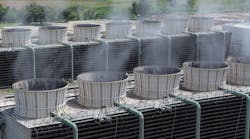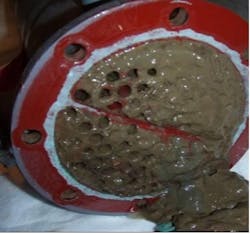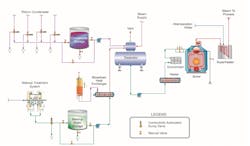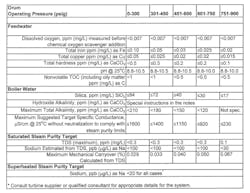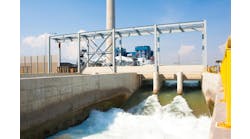Microbiological slime isn’t pretty, and it can lead to major fouling problems for heat exchangers. The cause of this unsightly sludge-like substance (see Figure 1) was among the topics addressed during the annual Electric Utility Chemistry Workshop (EUCW) in June at the University of Illinois. Other key issues discussed during the conference included steam generation chemistry, condensate return, developments in film-forming products (FFP) and high-purity makeup water production and makeup water purity.
Here’s a closer look at these event highlights to help chemical processing operators optimize their water/steam chemistry performance.
Common Cooling Water Problems and Solutions
Other key points related to cooling water developments at the pre-conference seminar included:
- Corrosion and scale control programs continue to improve with the introduction of advanced chemical formulations that directly protect metal surfaces. These programs have also allowed many plants to reduce or eliminate phosphorus (as inorganic and organic phosphates) in cooling tower discharge, which has important environmental benefits.
- Sophisticated computer software programs are now available to calculate chemical feed dosages, chemical inventories, alarm conditions and other parameters. Operators can configure the systems to provide data to any location within the plant and to outside experts for evaluation and faster response times.
Steam Generation Chemistry
Many coal-fired power plants have been replaced with combined cycle units that have heat recovery steam generators. Heat recovery boilers are also common at industrial plants. For units with high-purity feedwater (cation conductivity <0.2 μS/cm) and no copper alloys in the feedwater system, the (usually) recommended feedwater chemistry program is all-volatile treatment oxidizing (AVT(O)), with no oxygen scavenger feed. The chemistry is designed to reduce the potential for flow-accelerated corrosion (FAC) but is a concept that many combined-cycle plant personnel don’t understand. FAC is a serious phenomenon that has been responsible for many accidents, several with fatalities, at power plants in the United States. (2) At the 2023 EUCW, a colleague from a well-known utility outlined how his organization’s chemistry staff is installing supplemental feedwater and economizer oxygen injection systems to reduce FAC in existing heat recovery steam generators.
Figure 3 below is an extract taken from the recent revision of the American Society of Mechanical Engineers (ASME) industrial boiler water guidelines (3). It provides insight on impurity level limits for low- to medium-pressure water tube industrial steam generators.
Another topic at this year’s workshop was the continued development of FFP to protect steam generator internals. These products, both film-forming amines (FFA) and non-amines, have been widely advocated for more than a decade, with anecdotes circulating about their varying degrees of success and failure in real-world applications. Papers presented at the event demonstrated positive outcomes with FFA, including data showing the reduction of carbon steel corrosion during normal operation and unit outages.
However, even if an FFP trial indicates a product is effective, that doesn’t mean operators should abandon other recommended treatment methods, such as maintaining an alkaline pH in feedwater and boiler water.
High-Purity Makeup Water Production
For more than 30 years, the core technology of ion exchange for high-purity water production has been mostly replaced with reverse osmosis (RO) for bulk demineralization with mixed-bed ion exchange or continuous electrodeionization (CEDI) for RO permeate polishing. Also, the membrane technologies of micro- and ultrafiltration have become common as RO pretreatment methods to remove suspended solids.
Makeup water purity requirements can vary significantly depending on specific process needs, and careful consideration is important to avoid under or overdesigning makeup treatment systems. Sodium softening may be fine for low-pressure steam generators, but more advanced RO or ion exchange techniques are a must for high-pressure units.
EUCW began in 1981 to provide practical information on water/steam chemistry, makeup water treatment, cooling water treatment, and other issues for power plant personnel in the Midwest and around the country.
The EUCW planning committee focuses on topics important at many co-generation and industrial facilities. Learn more about next year’s event, June 4-6, 2024, in Champaign, Illinois via https://conferences.illinois.edu/eucw.
References
1. B. Buecker (Tech. Ed.), “Water Essentials Handbook”; 2023. ChemTreat, Inc., Glen Allen, VA. Currently being released in digital format at www.chemtreat.com.
2. B. Buecker, “HRSG Steam Generation Issues: Reemphasizing the Importance of FAC Corrosion Control, Parts 1-4”; Power Engineering, September-October 2022. The articles include references to additional sources that provide further information about FAC.
3. Consensus on Operating Practices for the Control of Feedwater and Boiler Water Chemistry in Modern Industrial Boilers, The American Society of Mechanical Engineers, New York, NY, 2021.
